-
 Snoflo Premium
Snoflo Premium
Get unlimited access to all our content
With no Ad interruptions! - Start Your Free Trial Login with existing account
Woodland
Eden Index
Climate
7.3
•
Recreation
3.4
•
Community
3.6
•
Safeguard
5.0/10

Woodland, Washington, located in Clark County, is a charming city surrounded by scenic natural beauty. With a mild climate, the town experiences warm summers and cool, wet winters. The average temperature in summer ranges from 70°F to 80°F, while winter temperatures vary between 30°F and 50°F.
Woodland is blessed with abundant water resources, thanks to its location near the Lewis River. The hydrology constituents in this area include the Lewis River, which provides ample recreational opportunities such as fishing, boating, and swimming. The river is known for its salmon and steelhead runs, attracting fishing enthusiasts from all over the region.
Outdoor recreation opportunities in Woodland are plentiful. The city offers several parks and trails, including Horseshoe Lake Park, which features a swimming beach, picnic areas, and hiking trails. Lewis River Golf Course attracts golf lovers, while Lewis River Park offers camping, hiking, and bird-watching opportunities.
In conclusion, Woodland, Washington enjoys a mild climate, abundant hydrology constituents, and a plethora of outdoor recreation opportunities. Whether you're a nature enthusiast, angler, or simply enjoy outdoor activities, Woodland provides a picturesque setting to explore and enjoy the great outdoors.
What is the Eden Index?
The Snoflo Eden Index serves as a comprehensive rating system for regions, evaluating their desirability through a holistic assessment of climate health, outdoor recreation opportunities, and natural disaster risk, acknowledging the profound impact of these factors on livability and well-being.
Climate Health Indicator (CHI): 7.3
Woodland receives approximately
1512mm of rain per year,
with humidity levels near 82%
and air temperatures averaging around
11°C.
Woodland has a plant hardyness factor of
8, meaning
plants and agriculture in this region tend to thrive here all year round.
By considering the ideal temperature range, reliable water supplies, clean air, and stable seasonal rain or snowpacks, the Climate Health Indicator (CHI) underscores the significance of a healthy climate as the foundation for quality living.
A healthy climate is paramount for ensuring a high quality of life and livability in a region, fostering both physical well-being and environmental harmony. This can be characterized by ideal temperatures, reliable access to water supplies, clean air, and consistent seasonal rain or snowpacks.
Weather Forecast
Streamflow Conditions
Lower Columbia
Area Rivers
Lower Columbia
Snowpack Depths
Lower Columbia
Reservoir Storage Capacity
Lower Columbia
Groundwater Levels
Recreational Opportunity Index (ROI): 3.4
The Recreational Opportunity Index (ROI) recognizes the value of outdoor recreational options, such as parks, hiking trails, camping sites, and fishing spots, while acknowledging that climate plays a pivotal role in ensuring the comfort and consistency of these experiences.
Access to outdoor recreational opportunities, encompassing activities such as parks, hiking, camping, and fishing, is crucial for overall well-being, and the climate plays a pivotal role in enabling and enhancing these experiences, ensuring that individuals can engage in nature-based activities comfortably and consistently.
Camping Areas
| Campground | Campsites | Reservations | Toilets | Showers | Elevation |
|---|---|---|---|---|---|
| Paradise Point State Park | 80 | 176 ft | |||
| Louis Rasmussen RV Park | None | 32 ft | |||
| Battle Ground Lake State Park | 46 | 477 ft | |||
| Seaquest State Park | 88 | 507 ft |
Catastrophe Safeguard Index (CSI):
The Catastrophe Safeguard Index (CSI) recognizes that natural disaster risk, encompassing floods, fires, hurricanes, and tornadoes, can drastically affect safety and the overall appeal of an area.
The level of natural disaster risk in a region significantly affects safety and the overall livability, with climate change amplifying these risks by potentially increasing the frequency and intensity of events like floods, fires, hurricanes, and tornadoes, thereby posing substantial challenges to community resilience and well-being.
Community Resilience Indicator (CRI): 3.6
The Community Resilience Indicator (CRI) recognizes that education, healthcare, and socioeconomics are crucial to the well-being of a region. The CRI acknowledges the profound impact of these elements on residents' overall quality of life. By evaluating educational resources, healthcare accessibility, and economic inclusivity, the index captures the essential aspects that contribute to a thriving community, fostering resident satisfaction, equity, and social cohesion.

